Faces of Myanmar – Part 4
Meet Charles and Eddie:
“Shit is from holy monkey! Shit means good luck!”
Incredulously I look at the two saffron-clad monks sitting side by side on a stone bench a few feet away from me. They appear to be beside themselves with glee, watching me balance on the narrow staircase, trying to clean my bare feet with
wet wipes.
Now, I have had plenty of people joshing with me in my life, but a couple of monks? That’s a first!
“Are you having me on?” I ask them unnecessarily.
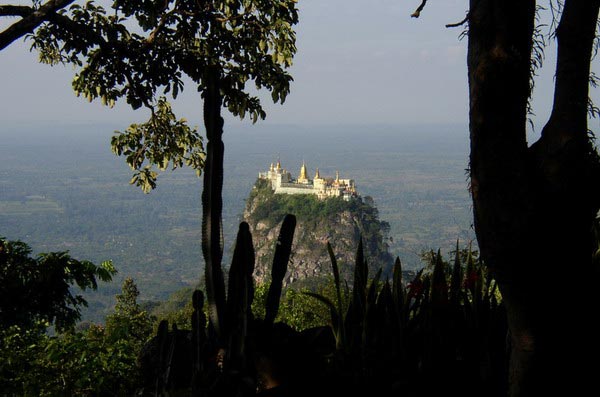
Mt Popa, a solitary green peak amid the yellowish-brown plains of desert-like central Myanmar. Said to be the core of an extinct volcano last active 250.000 years ago, it stands out, shimmering in the heat, like an emerald on gold setting.
Topped with a picturesque complex of monasteries, stupas, and shrines, it’s considered the abode of Burma’s most powerful Nat, powerful spirits that may hold dominion over a person or over a place, natural or human-made. These
Nat, a relict of the country’s pre-Buddhism era, when correctly propitiated, are said to aid worshippers in accomplishing important tasks, even vanquishing one’s enemies.
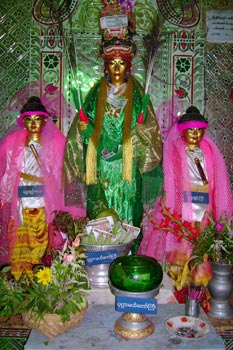
A winding, covered walkway, coming to pass many of the deeply revered mannequin-like figures representing the 37 Nat, leads from this rocky crag’s base via tight stairways to wide-open views.
Yet the rock is not only home to the spirit world, but also to packs of notoriously misbehaved monkeys, harassing this holy site’s visitors and pilgrims alike by snatching any food the uninitiated may carry with them, and most obnoxiously
defecating everywhere. At this they almost appear to find particular joy in covering the walkway’s stairs with their droppings, much to the chagrin of the unprepared bare footed visitor. 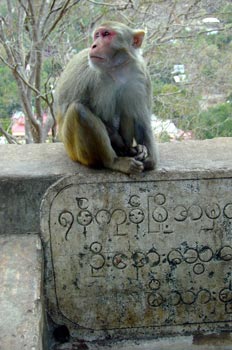
Subconsciously I thank the Nat of cleanliness for the timely intuition of taking wet wipes with me to the mountain.
“What is your name, how old are you, where do you come from?”
The two monks ask me the same ubiquitous questions in the same fashion as hundreds of acquaintances on my travels have done before them. Without awaiting my answer they go on introducing themselves:
“My name Charles, he name Eddie! We are pleased to meet you!”
I can’t help raising my eyebrows.
“Charles and Eddie?”, I ask them incredulously. “That’s supposed to be your real names?”
“No!”, they say and burst out laughing, “Of course not! Our teacher give us name! Good name for practice English he say! Now teacher is gone! He volunteer! Go home Australia already! Very bad! No have teacher anymore!
You stay teach us?”
One of them takes out a Cheroot cigar and offers it to me. As I decline, he takes out a box of matches and lights up himself.
“Well, I might consider, but only after I get done scrubbing all that monkey scat off my feet, and that might take a while”, I reply humorously.
“Are you serious?”, he laughs, winking at me.
“Charles and Eddie…Would I lie to you?”
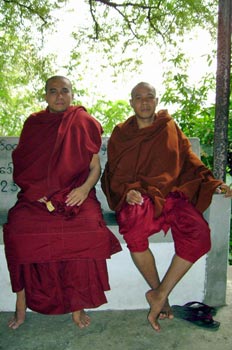
Meet Mya:
“I changed my mind! I will buy one of your paintings after all!”
Upon hearing me say this a smile explodes across Mya’s face as if someone has switched on a spotlight.
“I think you don’t like painting!”, she says. “You say they don’t fit bag!”
“Well, this one right here is actually after my fancy”, I lie, pointing at a brightly colored canvas painting depicting five saffron-robed monks with umbrellas walking towards the setting sun.
“Oh yes, this very nice, I make you good price! Seven Dollar okay?, she kicks off her sales pitch, asking timidly while averting her eyes from me.
“Sorry, I cannot pay you seven Dollars!”, I reply with a decisive voice.
She looks up at me again, her face openly showing traces of disappointment.
“Okay, I give you discount! Five dollars okay?”, she tries again.
“No, I am sorry, that’s just not possible!”
Mya cannot hide her disappointment anymore.
“Five dollar very good price! How much do you want to pay?”
I first direct my eyes at the painting, then hesitatingly back at her again, and heave a deep-drawn sigh.
Mya is in the “painting for tourists” business, along with seemingly hundreds of others whose mostly dilapidated sales stalls stud the vast area of the ancient city of Bagan. Dotting the 42 square kilometer riverside plain east
of the curving Ayeyarwady, its 3000-some temples not only make up the probably most wondrous sight in Myanmar, but rival Cambodia’s Angkor Wat in terms of scope and jaw-droppability.
I ran into Mya pedaling down one of the area’s countless dusty dirt tracks not long after sunrise on the ramshackle bicycle I had rented from my guesthouse the day before. Fully laden, carrying dozens of her furled paintings, she was
stumbling down the bumpy road towards the tall and majestic terraced temple in front of which she usually displays her art.
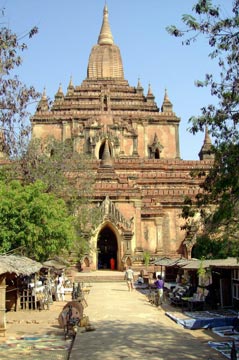
Spotting her on the track ahead of me the first thing I noticed about her was her incredibly long silky-smooth black hair, reaching all the way down her lower back and beyond. I don’t remember ever having seen a girl with hair as long as hers.
I couldn’t help wondering if she had ever had any of it cut off since the day she was born.
Taking a curious glimpse at her from the corner of my eyes while passing by on my bicycle she turns her head to me and smiles. Her face is dolloped with tan-colored thanakha, a paste made from the powdered ground bark of the thanakha tree,
popular with people all over the country as moisturizer, sunscreen, and perfume.
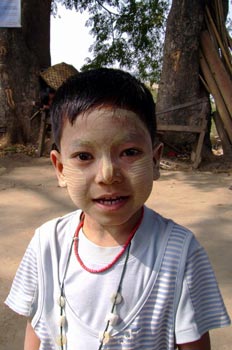
60 minutes later, stepping through the impressive temple structure’s huge main gate back out into the bright morning sunlight, I immediately spot her again. She has secured herself a prominent spot close to the gate to unfurl her merchandise. Her
being the first vendor on-site at this early morning hour, and me being the first and still only visitor to the temple, it’s hard to ignore each other.
“Sir, hello! You look pictures! Lovely souvenir! Lovely price!”
Unable to resist her friendly smile I step closer to take a look at the array of paintings she has spread out in front of her. Most of them show the same interchangeable motives of monks, temples, and folklore of the kind one can find at
pretty much every tourist site in the country. While I find many of them naively nice, I am afraid she’s not a very talented painter.
“No thank you! None of them would fit my bag!” I tell her apologetically, and ask for her name.
“My name Mya!”
At 25 years of age she is two years my junior. We strike up a conversation.
I learn that her father used to work for the Department of Archaeology. Until his unexpected and quite sudden death two years ago he used to be responsible for supervising the repairs and organizing the ongoing restoration of approximately
80 ancient temples in the area. This job provided him with an above average income of around 20 dollars per month. Not much, but enough to feed his family and care for his chronically ill wife, Mya’s mother.
Since he died, caring and providing for her ailing mother and her teenage sister has been solely Mya’s responsibility and burden. For want of a better earning opportunity she paints and tries selling her craft to the ever increasing
number of tourists visiting the region. If she’s lucky she sells three to four paintings per month, at a price of four to eight dollars each. Competition is harsh, she says.
Rainy season is the time for her to paint, as there are far less visitors. In high season she hasn’t got time for that. She’s usually out at the temple by 6.30am, and stays until after dusk, the time after the great sunset chase,
when the last hoards of tourists scurry down the pagoda stairways from atop the temples and back to town.
She tries not to take more than one or maybe two days off per month. She cannot afford someone else taking her place at the temple. For her place she has to pay tea money, read bribes, to the administration officials in the Bagan Archeological
Zone. Her father having been one of those officials doesn’t save her.
After answering her curious questions about me I ask her to point out a good place to me from where I will be able to quietly enjoy the lovely evening ambiance over Bagan later in the day, away from the noisy tour groups that tend to
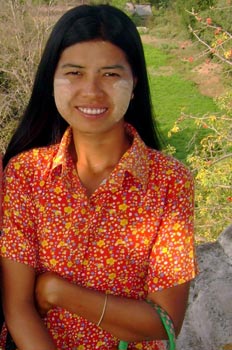 engross the tallest structures at sunset. She offers to show me. All I have to do is to return to this very spot one hour before dusk. How can I resist such offer?
engross the tallest structures at sunset. She offers to show me. All I have to do is to return to this very spot one hour before dusk. How can I resist such offer?
Hours later I return, and sure enough find her in the very same spot next to the temple gate, slurping down a bowl of Mohinga, Burma style rice noodles with bits of fish. After helping her to pack up her art, she leads me down a narrow path
through the undergrowth to a smaller yet still towering terraced structure a few hundred meters away.
Twinkle-toed she leads the way through the temple’s inner passages. I follow, much to her amusement struggling with my body height, scraping through the network of passageways, leading to the main raised square platform, and finally
further up steep steps to a small deck around the stupa.
There we sit side by side at the rim, our feet dangling, waiting for the sun to dip behind the mountains and colors to show. As the Bagan sprawl finally starts turning all shades of tangerine, lavender, and rust we grow quiet.
“I am sorry! I think I cannot pay you any less than fifteen dollars for the painting!”
“Sorry! What!?”
Stickman's thoughts:
Another great travel series, and yet more proof (as if it was necessary) that great stories don't have to include the bar scene.



